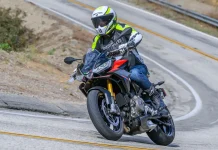Every structure has a foundation. Be it the humble red barn or skyscraper reaching to the heavens, both of them sit on what is hopefully an unwavering foundation. When discussions of riding craft come up in the paddock garages, a more learned rider may opine about the importance of fundamental skills to rely on, and I like to call these skills: The Foundation.

The Foundation will alter slightly depending on your discipline, and that’s fine. Your bag of tricks needs to be filled with tools that fit your line of work, and figuring out what those tools are is half the battle anyway.
Let’s provide a little context first. See, testing a variety of motorcycles generally means that you’ll ride things of all different shapes, sizes, and what-have-you at any given moment. The weather changes, as does the environment, climate, and even you change. Maybe you woke up on the right side of the bed and are now gracing the porcelain throne with pure excellence. Or, perhaps, you’re at the opposite end of the spectrum, and I’ll allow you to paint whatever picture your imagination conjures.
That’s at the extreme end. Ordinary people don’t hop from bike to bike regularly. We might have a few ponies in the stable, and we might even be a few different breeds. But, unless you’re a genuinely well-heeled individual, our personal choices come down to one or two options. Having a base of skills allows you to focus on what’s going on around you, without getting caught up in all the variables coming your way.

As with people, jumping to a new motorcycle requires an interview process. Some riders blaze through that process faster than others, but we all do it, regardless of skill or experience. What are your greatest strengths, weaknesses, so on and so forth.
Recently, I was at a track day with a rider who had traded in his twin-cylinder supersport for an inline-four-cylinder machine. On paper, those motorcycles are direct competitors. You’d probably even see them in comparison tests. But, they want to be ridden in different manners. The low-down and midrange punch of the twin-cylinder machine means that this rider isn’t used to keeping that high-revving inline-four screaming in the upper rev range. While that might be the most significant change, the rider triangle, brakes, chassis, and nearly everything else are all slightly altered from what this rider knows.
A few sessions into the day, the said rider commented that he was blowing lines, his corner entries were all over the place, and he couldn’t seem to wrap his head around what was happening. Luckily, his spirits were high, and he was enjoying his new ride. We all talked a bit, and a laundry list of differences came up, which is good—he was identifying character qualities and coming up with solutions to negotiate each of them.
Change is good and from where I’m sitting is simply another word for experience. So, what doesn’t change: The Foundation. Remember, every bit of nuance, window dressing, plastic, electronics (or lack thereof) sits atop that basic foundation. His shiny new supersport is radically different from the bike he developed his skills on, which threw him for a loop. A motorcycle is still two wheels, a chassis, and an engine, at the end of the day.
We went over the basic riding principles and a few key points at that particular racetrack. By and large, the collective advice given to our garage-mate was focusing on the fundamentals: Vision, brakes, and throttle. A session or two later, he found a groove that allowed him to knock seconds off his lap time and start working on making that new bike, his bike.
The bikes, scenery, weather, and situation all impact a ride. There is no doubt about that. But, alas, they’re variables. The Foundation is what helps experienced riders look through the challenges facing them and peel things back to their core. And that’s something that all riders can build on.
Nic is shown testing the Aprilia RSV4, KTM 1290 Super Duke R, Triumph Thruxton RS, and Ducati Panigale V2.







